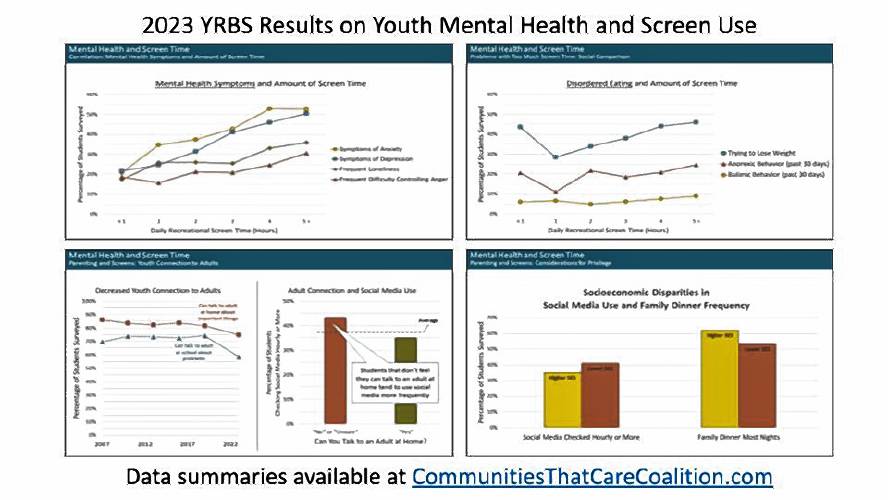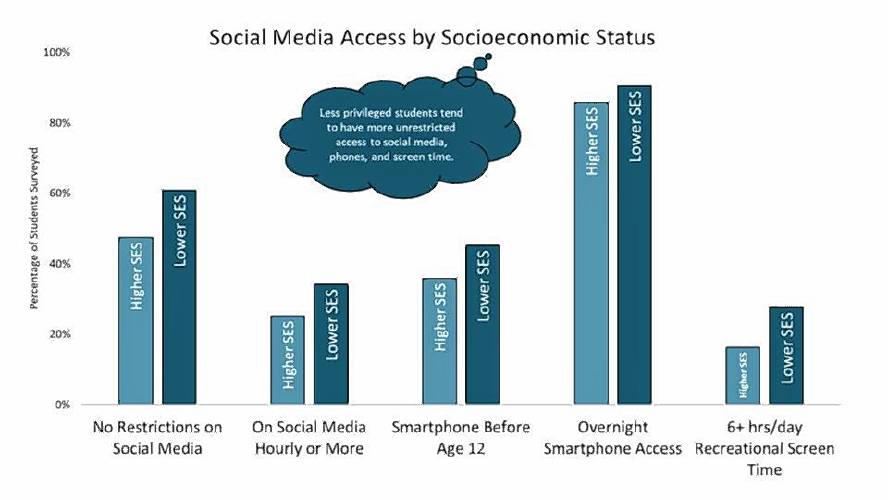Survey shows teen screen use, on the rise since 2007, dips from 2021 peak
| Published: 10-22-2024 5:56 PM |
This article is the third in a four-part series exploring the results of the Communities That Care Coalition’s 2024 Student Health Survey. The Communities That Care Coalition is co-hosted by the Franklin Regional Council of Governments (FRCOG) and Community Action Pioneer Valley.
Nearly one in every four teenagers surveyed in the Communities That Care Coalition’s 2024 Student Health Survey reported spending six or more hours a day staring at a screen, while roughly 65% reported more than three hours of screen time each day.
Since 2003, the Communities That Care Coalition has surveyed more than 40,000 students in grades eight, 10 and 12 from all nine public school districts in Franklin County and the North Quabbin region to evaluate youth habits and overall emotional and physical health.
The numbers represent a slight decline from 2021 when youth screen time peaked, with roughly 70% of those surveyed reporting more than three hours of recreational screen time each day. However, screen use among teens has been on the rise since 2007, when only 17% of youth reported spending three or more hours a day staring at a screen. Ten years ago, 38% of students met the same criteria.
“It’s a big increase. I find it striking that we had this huge increase with the pandemic, kids spending so much time online, but we haven’t really gone down from there,” Communities That Care Coalition Coordinator Kat Allen said.
Allen clarified that the screen time students reported was purely recreational and does not reflect computer time spent on homework or school. She noted that although the upward trend reflects national increases in screen time among adults, exorbitant screen time for youth can lead to exposure to pornography and extremist content.
In 2023, Allen said 23% of the surveyed students reported that they were exposed to pornography without consent in school — mostly in middle school, with roughly 7% in elementary school and another 7% in high school.
“Excessive screen time is related to poor mental health, less sleep, less exercise, excessive social comparison, less connection to adults, etc,” Allen said. “For young people, unsupervised screen time can also mean exposure to harmful content, such as extremism, hate speech, content that promotes disordered eating, pornography or online gambling.”
Article continues after...
Yesterday's Most Read Articles
Communities That Care Coalition Evaluation Coordinator Nick Hathaway added that the stark rise in youth screen time might be correlated to the decline in age at which most children receive their first cellphones.
Hathaway also noted that the amount of time students spend on recreational screen time is closely linked to socioeconomic status, with wealthier families reportedly checking their children’s social media use more frequently than less privileged families.
“The percent of students who have no restrictions on social media is much higher for less privileged students, and the percent of less privileged students who are on social media hourly or more is much higher,” Hathaway said. “The percentage of those who got a smartphone before age 12 was much higher [among this demographic], overnight smartphone access a little bit higher as well.”
As social media and internet use becomes more deeply ingrained in youth culture, Allen said parental controls over youth internet use — such as child-friendly phones with restricted internet access for younger students, or “contracts” with teens to set healthy screen use limits — can help mitigate the unhealthy consequences associated with screen time.
“It takes an awful lot of resources to be able to limit and monitor kids’ phone use and, in many cases, parents have to use phones for child care because they don’t have another option,” Allen said. “Youth continue to report a lot of screen time and the rates continue to increase.”
Anthony Cammalleri can be reached at acammalleri@recorder.com or 413-930-4429.








 ‘It’s a Wonderful Night in Turners Falls’ showcases village businesses, nonprofits
‘It’s a Wonderful Night in Turners Falls’ showcases village businesses, nonprofits Sackrey Construction Co. of Sunderland celebrating 35 years in business
Sackrey Construction Co. of Sunderland celebrating 35 years in business Photo: As darkness falls
Photo: As darkness falls Leverett residents rap Kittredge compound plans, urge caution as negotiations for 400 homes move forward
Leverett residents rap Kittredge compound plans, urge caution as negotiations for 400 homes move forward 
